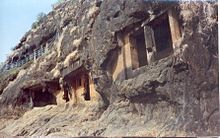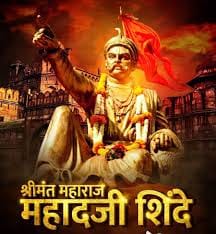Nasik Caves
Nasik Caves
The Nasik Caves, or sometimes Pandavleni Caves (or Pandu Lena,[1] Pandu Caves or Trirashmi Leni, Trirashmi being the name of the hills in which the caves are located, Lenibeing a Marathi word for caves), are a group of 24 caves carved between the 1st century BCE and the 3rd century CE, though additional sculptures were added up to about the 6th century, reflecting changes in Buddhistdevotional practices mainly.[2] Buddhist sculptures are a significant group of early examples of Indian rock-cut architectureinitially representing the Hinayana tradition. Most of the caves are viharas except for Cave 18 which is a chaitya of the 1st century BCE.[3]The style of some of the elaborate pillars or columns, for example in caves 3 and 10, is an important example of the development of the form [4]. The location of the caves is a holy Buddhist site and is located about 8 km south of the center of Nashik (or Nasik), Maharashtra, India, The "Pandavleni" name sometimes given to the Nasik Caves has nothing to do with the characters Pandavas, characters in the Mahabharata epic. Other caves in the area are Karla Caves, Bhaja Caves, Patan Cave and Bedse Caves.
| Nasik Caves Buddhaleni Caves | |
|---|---|
 Nasik Caves, Cave No. 17, built circa 120 CE. | |
| Location | Nashik, Maharashtra, India |
| Coordinates | 19.9412°N 73.7486°E |
CavesEdit
The caves, known as Pandu Caves also known as Trirashmi Buddhist Caves were carved out from the 1st century BCE until the 3rd century CE, with later additions of sculptures.[5] They were paid for by local Buddhist royalty, merchants and local people for the Buddhist monks. The name is derived from the word "Tiranhu" which is inscribed in the Caves.[6][7] It means "rays of sunlight" which is quite obviously referring to the rays of sunlight emerging from behind the Caves as seen from the village. These caves were carved and donated by various kings that ruled Nashik - The Satavahanas, The Nahapanas, The Abhirs. The caves lodge idols of Buddha and Bodhisattva. Some caves are intricately connected by stone-cut ladders that join them to the other caves. Steps lead to the caves from the bottom of the hill. The peak of the Trirashmi Caves is also accessible by trekking of about 20 mins but the path is well built with steps.[8]

These caves are one of the oldest caves of Maharashtra. Some of the caves are large and contain numerous chambers - these rock-cut caves served as a viharas or monasteries for the disciples to meet and hear sermons. They contain interesting sculptures. One of the vihara caves is older and finer in sculptural detail and is thought to be nearly as old as the Karla Cave near Lonavala. Another cave (cave No. 18) is a chaitya and is similar in age to that at the Karla Caves and has a particularly elaborate facade. Chaityas are used for chanting and meditation.
The cave has images of Buddha, Bodhisattva, sculptures representing the King, farmers, merchants and rich iconography depicting a beautiful amalgamation of Indo - Greek architecture[9][10]
The site has an excellent ancient water management system and skillfully chiseled out of solid rock are several attractive water tanks.[11]
HistoryEdit
The caves can be traced back up to the 1st century BCE by inscriptions recording donations.[12] Out of the twenty-four caves, two caves are a major attraction - the main cave which is the Chaitya (prayer hall) has a beautiful Stupa; the second one is cave no. 10 which is complete in all structural as well inscriptions. Both the caves have pictures of Buddha come out of a printer stuck all over the rocks there is also no water supply there. The caves are facing eastwards. So it is recommended to visit the caves early morning as in sunlight the beauty of carvings is enhanced.
The caves were called Pundru which in Pali language means "yellow ochre color". This is because the caves were the residence of Buddhist monks who wore "the chivara or the yellow robes". Later on, the word Pundru changed to Pandu Caves (as per Ancient Monuments Act 26 May 1909). Decades later people started calling it Pandav Caves - a misnomer which is used for every cave in India.
The various inscriptions confirm that Nashik in that period was ruled by 3 dynasties – the Western Kshatrapas, the Satavahanas and the Abhiras. It seems there was always a conflict between Satavahanas and the Kshatrapas over supremacy. However, all the 3 kings fully supported Buddhism. The inscriptions also confirm that apart from the kings, local merchants, landlords too supported and donated huge sums for the development of these caves.
Layout and contentEdit
The group of 24 caves was cut in a long line on the north face of a hill called Trirasmi. The main interest of this group lies not only in its bearing on its walls a number of inscriptions of great historical significance belonging to the reign of Satavahana & Kshaharatas or Kshatrapas. But also in its representing a brilliant phase in the Rock-Cut architecture of the second century CE. There are altogether 24 excavations though many of these are small & less important. Beginning at the east end they may conveniently be numbered westward. They are almost entirely of an early date and were excavated by the Hinayanasect. Mostly, the interior of the caves are starkly plain, in contrast to the heavily ornamented exterior.
The caves and their inscriptions
RoutesEdit
The caves are located high in the mountains of Trirashmi. Some caves are intricately connected by stone-cut ladders that join them to the other caves. Steps lead to the caves from the bottom of the hill. The peak of the Trirashmi Caves is also accessible by trekking of about 20 mins but the path is treacherous and dangerous.[55]
See alsoEdit
ReferencesEdit
- ^ Michell, 383
- ^ Michell, 384
- ^ Michell, 384
- ^ Harle, 55-56
- ^ Michell, 384
- ^https://www.maharashtratourism.gov.in/treasures/caves
- ^ http://www.nashikonline.in/city-guide/pandavleni-caves-of-nashik
- ^ "Trirashmi Buddhist Caves". showcaves.com. Retrieved 16 September 2006.
- ^ http://www.ajanta-ellora.com/pandavleni-caves.html
- ^http://www.maharashtratourism.net/caves/pandavleni-caves.html
- ^ "Pandavleni Caves". india9. Retrieved 16 September 2006.
- ^ Michell, 384
- ^ a b c d e f g h i j k l m n o p q r s t The cave temples of India, Fergusson, James, W.H. Allen &Co p.267ff (Public domain text)
- ^ Epigraphia Indica p.59
- ^ a b c Epigraphia Indica p.60ff
- ^ Epigraphia Indica p.71ff
- ^ a b Hultzsch, E. (1906). Epigraphia Indica Vol.8. p. 60.
- ^ Epigraphia Indica p.61-62
- ^ Epigraphia Indica p.66-67
- ^ Singh 2008, p. 383.
- ^ A History of Ancient and Early Medieval India Upinder Singh p.384
- ^ Sudhakar Chattopadhyaya 1974, p. 92.
- ^ Epigraphia Indica p.71-72
- ^ Epigraphia Indica p.71-72
- ^ a b c Epigraphia Indica p.75ff
- ^ World Heritage Monuments and Related Edifices in India, Volume 1 ʻAlī Jāvīd, Tabassum Javeed, Algora Publishing, 2008 p.42
- ^ Southern India: A Guide to Monuments Sites & Museums, by George Michell, Roli Books Private Limited, 1 mai 2013 p.72
- ^ "This hall is assigned to the brief period of Kshatrapas rule in the western Deccan during the 1st century." in Guide to Monuments of India 1: Buddhist, Jain, Hindu - by George Michell, Philip H. Davies, Viking - 1989 Page 374
- ^ a b Salomon, Richard (1998). Indian Epigraphy: A Guide to the Study of Inscriptions in Sanskrit, Prakrit, and the Other Indo-Aryan Languages. Oxford University Press, USA. pp. 88–89. ISBN 9780195099843.
- ^ Epigraphia Indica p.81-82
- ^ Epigraphia Indica p.78-79
- ^ Epigraphia Indica p.82-83
- ^ Epigraphia Indica Vol.2 p.78-79
- ^ a b c d e Epigraphia Indica p.90ff
- ^ Banerjee, Gauranga Nath. Hellenism in Ancient India. p. 20.
- ^ Bhandarkar. Some Aspects of Ancient Indian Culture. p. 60.
- ^ a b c d e f g The cave temples of India, Fergusson, James, W.H. Allen &Co p.271ff (Public domain text)
- ^ Fergusson, James; Burgess, James (1880). The cave temples of India. London : Allen. p. 348-360.
- ^ Archaeological survey of India [1]Archived 26 September 2013 at the Wayback Machine
- ^ The Greeks in Bactria and India by William Woodthorpe Tarn p.257
- ^ a b Spink, Walter M. (2005). Ajanta: Painting, sculpture, architecture. BRILL. p. 1. ISBN 900414983X.
- ^ a b Le, Huu Phuoc (2010). Buddhist Architecture. Grafikol. p. 108. ISBN 9780984404308.
- ^ a b c Epigraphia Indica p.91ff
- ^ a b c d e f g Epigraphia Indica p.93 Inscription No.22
- ^ Carla M. Sinopoli 2001, p. 168.
- ^ Burgess. Epigraphia Indica Vol 8. p. 93.
- ^ a b The cave temples of India, Fergusson, James, W.H. Allen &Co p.274ff (Public domain text)
- ^ Brancaccio, Pia (2010). The Buddhist Caves at Aurangabad: Transformations in Art and Religion. BRILL. p. 61. ISBN 9004185259.
- ^ Empires: Perspectives from Archaeology and History by Susan E. Alcock p.168
- ^ Archaeological survey of India [2]Archived 26 September 2013 at the Wayback Machine
- ^ a b c d e f g The cave temples of India, Fergusson, James, W.H. Allen &Co p.275ff (Public domain text)
- ^ Burgess, Jas (1883). Archaeological Survey Of Western India. p. 114.
- ^ a b The cave temples of India, Fergusson, James, W.H. Allen &Co p.277ff (Public domain text)
- ^ The cave temples of India, Fergusson, James, W.H. Allen &Co p.278ff (Public domain text)
- ^ "Pandavleni Caves". Archived from the original on 7 January 2009. Retrieved 16 March 2008.
- Inscriptions on Cave 10, 13, 15, 16
- Maharashtratil Buddha Dhammacha Itihas
- M.S.More
- Leni Maharashtrachi
- Dawood Dalvi
- https://web.archive.org/web/20130926230100/http://asi.nic.in/asi_monu_tktd_maha_pandulenacaves.asp
SourcesEdit
- Harle, J.C., The Art and Architecture of the Indian Subcontinent, 2nd edn. 1994, Yale University Press Pelican History of Art, ISBN 0300062176
- Michell, George, The Penguin Guide to the Monuments of India, Volume 1: Buddhist, Jain, Hindu, 1989, Penguin Books, ISBN 0140081445
- Singh, Upinder (2008). A History of Ancient and Early Medieval India: From the Stone Age to the 12th Century. Pearson Education India. ISBN 978-81-317-1120-0.
- Sudhakar Chattopadhyaya (1974). Some Early Dynasties of South India. Motilal Banarsidass. ISBN 978-81-208-2941-1.
External linksEdit
| Wikimedia Commons has media related to Pandavleni Caves. |




Comments
Post a Comment